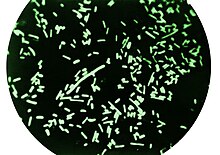| Shigella dysenteriae | |
|---|---|

| |
| Dark-field microscopy revealing Shigella dysenteriae bacteria | |
| Scientific classification | |
| Domain: | Bacteria |
| Phylum: | Pseudomonadota |
| Class: | Gammaproteobacteria |
| Order: | Enterobacterales |
| Family: | Enterobacteriaceae |
| Genus: | Shigella |
| Species: | S. dysenteriae
|
| Binomial name | |
| Shigella dysenteriae (Shiga 1897)
Castellani & Chalmers 1919 | |
This article needs additional citations for verification. (February 2010) |
Shigella dysenteriae is a species of the rod-shaped bacterial genus Shigella.[1] Shigella species can cause shigellosis (bacillary dysentery). Shigellae are Gram-negative, non-spore-forming, facultatively anaerobic, nonmotile bacteria.[2] S. dysenteriae has the ability to invade and replicate in various species of epithelial cells and enterocytes.[3]
- ^ Rodriguez, Margaret (2022). "16. Gram negative bacilli and coccobacilli: Enterobacteriaceae, Shigella". Microbiology for Surgical Technologists (3rd ed.). Cengage. pp. 222–224. ISBN 978-0-357-62624-5.
- ^ Hale, Thomas L.; Keusch, Gerald T. (1996). "Shigella: Structure, Classification, and Antigenic Types". In Baron, Samuel (ed.). Medical microbiology (4 ed.). Galveston, Texas: University of Texas Medical Branch. ISBN 978-0-9631172-1-2. Retrieved February 11, 2012.
- ^ Ryan, Kenneth James (2018). "Chapter 33: Enterobacteriaceae". Sherris Medical Microbiology (7th ed.). McGraw-Hill Professional Med/Tech.